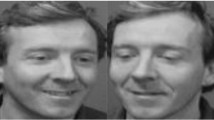Abstract
This paper discusses Gaussian decomposition of facial images for robust recognition. While it cannot sufficiently extract an effective component, it can decompose an image into two effective components, the filtered image and its residual. The Gaussian component represents rough information for a lighting condition and small individuality. The residual represents individuality and the other information including small noise. The two components complement each other and they are evaluated independently in the framework of eigenface method. The image decomposition can also collaborate with parallel partial projections for robust recognition.
Preview
Unable to display preview. Download preview PDF.
Similar content being viewed by others
References
Turk, M., Pentland, A.: Eigenfaces for recognition. Journal of Cognitive Neuroscience 3, 71–86 (1991)
Moghaddam, B., Pentland, A.: Probabilistic visual learning for object representation. IEEE Trans. Pattern Analysis and Machine Intelligence 19, 696–710 (1997)
Sakaue, F., Shakunaga, T.: Combination of projectional and locational decompositions for robust face recognition. In: Proc. IEEE International Workshop on Analysis and Modeling of Faces and Gestures, pp. 407–421 (2005)
Shakunaga, T., Shigenari, K.: Decomposed eigenface for face recognition under various lighting conditions. In: Proc. CVPR2001, vol. 1, pp. 864–871 (2001)
Wang, H., Li, S., Wang, Y.: Face recognition under varying lighting conditions using self quotient image. In: Proc. IEEE FG2004, pp. 819–824 (2004)
Marr, D., Hildreth, E.C.: Theory of edge detection. Proc. Royal Society, London B 207, 187–217 (1980)
Georghiades, A., Belhumeur, P., Kriegman, D.: From few to many: Generative models for recognition under variable pose and illuminations. In: Proc. FG 2000, pp. 277–284 (2000)
Georghiades, A., Belhumeur, P., Kriegman, D.: From few to many: illumination cone models for face recognition under variable lighting and pose. IEEE Trans. Pattern Analysis and Machine Intelligence 23(6), 643–660 (2001)
Okabe, T., Sato, Y.: Object recognition based on photometric alignment using ransac. In: Proc. CVPR 2003, vol. 1, pp. 221–228 (2003)
Batur, A., Hayes III, M.: Linear subspaces for illumination robust face recognition. In: Proc. ICCV2001, vol. II, pp. 296–301 (2001)
Martinez, A., Benavente, R.: The AR face database. Technical Report #24, CVC (1998)
Author information
Authors and Affiliations
Editor information
Editors and Affiliations
Rights and permissions
Copyright information
© 2006 Springer-Verlag Berlin Heidelberg
About this paper
Cite this paper
Sakaue, F., Shakunaga, T. (2006). Gaussian Decomposition for Robust Face Recognition. In: Narayanan, P.J., Nayar, S.K., Shum, HY. (eds) Computer Vision – ACCV 2006. ACCV 2006. Lecture Notes in Computer Science, vol 3851. Springer, Berlin, Heidelberg. https://doi.org/10.1007/11612032_12
Download citation
DOI: https://doi.org/10.1007/11612032_12
Publisher Name: Springer, Berlin, Heidelberg
Print ISBN: 978-3-540-31219-2
Online ISBN: 978-3-540-32433-1
eBook Packages: Computer ScienceComputer Science (R0)




